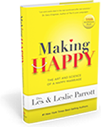Let’s face it, marriage retreats (which are wonderful things, we enjoy them) involve a nice mix of laughter, relaxation, as much socializing as you like, time away from the kids, and lessons about how to communicate better and how to fight fair. The curriculum for most of them—no matter who is teaching and what book they’re selling—is pretty much the same. By the time you’ve attended three or four of these kinds of sessions—or presented forty or fifty of them—you already know the drill. Whether you’re watching for clues on a Power-Point presentation, laughing at silly video clips, or filling in the blanks of a workbook, when it’s all said and done the material is pretty much the same.
Fight fair. Communicate better. Go on date nights more often.
The messages are often the same, definitely repetitive. So why do couples keep coming back for more of this?
We ask them, and from one coast of North America to the other, they tell us. Across Europe and Asia, they say the same thing.
“There has to be more,” couples tell us, especially those in their twenties and thirties. “We know our marriage can be better than this, but how? We’re tired all the time, all we do is chase the kids around, go to work and come back, and try to survive till tomorrow.”
Couples with infants and very young children are even more direct.
“I’m going crazy!” a young mom may tell us. Beside her, her husband often smiles or affirms the statement. Then we listen as one or both of them complain to us about late-night feedings, colic, childhood diseases, the baby’s lack of interest in feeding—all of which are early parenting issues that are normal to life, but cause couples stress and uncertainty. Each couple seems to think they’re unpacking a unique or special situation. Instead, after more than two decades of doing this professionally, we can proclaim with certainty that most marriages experience these same seasons and these same obstacles along the pathway to maturity, intimacy, and lasting love.
Would you find it hard to believe—some couples attend these events just to get away from their screaming kids for a while? Can you blame them? It’s fairly easy to find a few weekend babysitters, particularly among your church friends and relatives, if you present a noble cause like going to a marriage enrichment retreat. People are glad to help, and if you belong to at least a medium-sized church you probably won’t lack for volunteers to watch your kids while you get away to work on your relationship.
Grandparents, aunts and uncles, and married and single siblings may be more than ready to volunteer their services, especially if they believe they’re helping you learn and grow as a couple.
Even empty-nesters are repeat visitors at our retreats. “We feel like we don’t know each other anymore,” they’ll tell us. “Now that the kids are gone, we’re finding that we don’t have much in common. It’s scary—maybe this is why so many couples break up even after a long time of being together.”
One way or another, couples attending their second or fifth or ninth marriage renewal event tell us they’re searching for something deeper and better, no matter what stage of life they’re in or how old their children are. Couples without children come to marriage retreats too—the core issues of striving toward unity are at the heart of good marriage relationships in all seasons. These issues are not connected to family size, or age, or demographics of region, economic status, culture, or race.
Many couples come to one marriage retreat, then later come back for another one. They’re searching for techniques or mechanics or steps or a program that will solve their deep yearning to be together as one—at the soul level, not just in zip code.
Like U2, they still haven’t found what they’re searching for. But greatly to their credit, at least they don’t give up.
Thirty minutes after Garrett and Danielle arrive for their first counseling session, we are starting to make a little progress together. We’ve all gotten more comfortable—the couple’s fake fight seems to have relaxed them. It’s time for me to begin telling them what their relationship needs.
They’re not prepared for the answer I give them.
What your marriage needs, I explain to them carefully, is…more TV.
Both of them stare at me like I’ve gone completely insane. More TV?
After a moment’s pause, Garrett gives me a knowing nod, looking at me with an expression that seems to say, “Dude, this is such excellent advice!” He appears to believe I am advising him to get the full NFL package, every game all season long, plus the NBA and NHL full-season add-ons.
More TV?
Garrett is buying into this big-time. He likes counseling now. He’s become a believer, and he’s ready to champion my cause forever.
I ruin the moment by explaining to him what I mean.
TV is the absolute key to understanding how relationships go from good to great, how close friendships or marriages or accountability groups or investment partnerships make the journey from just-hanging-out-together to we’re-bonded-for-life greatness.TV is an acronym for the two most important qualities you need in order to succeed. So before we return to Garrett and Dani’s journey, let’s look at some TV.
T Is for Transparency
T is for transparency. You won’t move an existing relationship to a deeper level until you’re willing to let people see you as you are, for who you are, without pretending to be more cool, more smart, more together, more self-controlled, or more anything else than you really are. How many genuinely transparent people do you know? Go ahead and count them on your fingers. Don’t worry about it: You won’t need both hands.
When the container of a light source is transparent we can see right through it. By contrast, a container that is translucent lets much of the light shine through, but doesn’t let us see what’s inside it. That’s a major difference. There are some things we may be able to see, while many other things remain hidden from our view.
Most of us, whether consciously or not, grow up making the choice to be translucent people. We are opaque and cloudy, presentable on the surface, yet the inside is shrouded in mystery. Light may flow out of us, but no one can see where it comes from.
V is for Vulnerability
The V in TV is for vulnerability. Vulnerability is about choosing to be weak instead of strong, open instead of closed, caring and feeling instead of remaining aloof. Rabbits and deer are vulnerable; porcupines and armadillos much less so.
We’re born like rabbits and deer. We are defenseless and vulnerable, and this is why our birth parents or the other adults who raise us try to protect us and keep us safe. But one way or another as we emerge into real life, we begin forming relationships and we get hurt. We trust a friend who betrays our secrets, we fall for a first crush who then abandons us, or we get involved in a close relationship that crashes and burns, wounding us deeply.
One way or another many of us end up choosing to be more like porcupines or armadillos. We may interact with people, but now we’ve got our guard up for good. We’re wearing the armor. We hide our true selves behind layers of sharp points and thick skin, hidden away behind protective devices meant to keep us from further pain.
Adapted from Soul-Mate Marriage
Copyright © 2008 by David and Lisa Frisbie, Used with Permission, Published by Harvest House.











